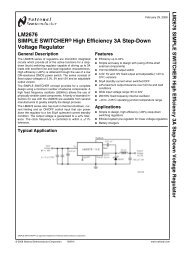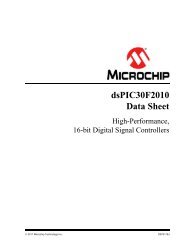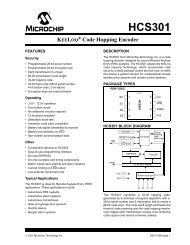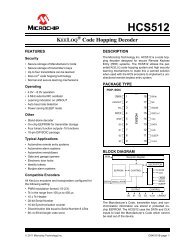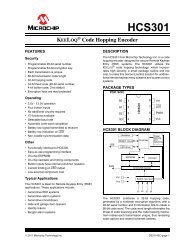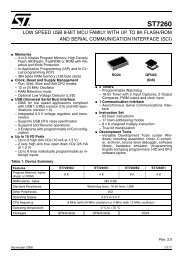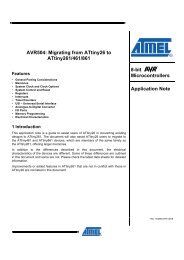You also want an ePaper? Increase the reach of your titles
YUMPU automatically turns print PDFs into web optimized ePapers that Google loves.
Embedded memory<br />
<strong>STM32W108C8</strong><br />
4.1 Flash memory<br />
The <strong>STM32W108C8</strong> provides a total of 66.5 Kbytes of Flash memory in three separate<br />
blocks:<br />
● Main Flash Block (MFB)<br />
● Fixed Information Block (FIB)<br />
● Customer Information Block (CIB)<br />
The MFB is divided into 641024-byte pages. The CIB is a single 512-byte page. The FIB is a<br />
single 2048-byte page. The smallest erasable unit is one page and the smallest writable unit<br />
is an aligned 16-bit half-word. The flash is rated to have a guaranteed 1,000 write/erase<br />
cycles. The flash cell has been qualified for a data retention time of >100 years at room<br />
temperature.<br />
Flash may be programmed either through the Serial Wire/JTAG interface or through<br />
bootloader software. Programming flash through Serial Wire/JTAG requires the assistance<br />
of RAM-based utility code. Programming through a bootloader requires specific software for<br />
over-the-air loading or serial link loading. A simplified, serial-link-only bootloader is also<br />
available preprogrammed into the FIB.<br />
4.2 Random-access memory<br />
The <strong>STM32W108C8</strong> has 8 Kbytes of static RAM on-chip. The start of RAM is mapped to<br />
address 0x20000000. Although the ARM® Cortex-M3 allows bit band accesses to this<br />
address region, the standard MPU configuration does not permit use of the bit-band feature.<br />
The RAM is physically connected to the AHB System bus and is therefore accessible to both<br />
the ARM® Cortex-M3 microprocessor and the debugger. The RAM can be accessed for<br />
both instruction and data fetches as bytes, half words, or words. The standard MPU<br />
configuration does not permit execution from the RAM, but for special purposes, such as<br />
programming the main flash block, the MPU may be disabled. To the bus, the RAM appears<br />
as 32-bit wide memory and in most situations has zero wait state read or write access. In<br />
the higher CPU clock mode the RAM requires two wait states. This is handled by hardware<br />
transparent to the user application with no configuration required.<br />
4.2.1 Direct memory access (DMA) to RAM<br />
Several of the peripherals are equipped with DMA controllers allowing them to transfer data<br />
into and out of RAM autonomously. This applies to the radio (802.15.4 MAC), general<br />
purpose ADC, and both serial controllers. In the case of the serial controllers, the DMA is full<br />
duplex so that a read and a write to RAM may be requested at the same time. Thus there<br />
are six DMA channels in total.<br />
The <strong>STM32W108C8</strong> integrates a DMA arbiter that ensures fair access to the<br />
microprocessor as well as the peripherals through a fixed priority scheme appropriate to the<br />
memory bandwidth requirements of each master. The priority scheme is as follows, with the<br />
top peripheral being the highest priority:<br />
1. General Purpose ADC<br />
2. Serial Controller 2 Receive<br />
3. Serial Controller 2 Transmit<br />
4. MAC<br />
5. Serial Controller 1 Receive<br />
27/215 Doc ID 018587 Rev 2





